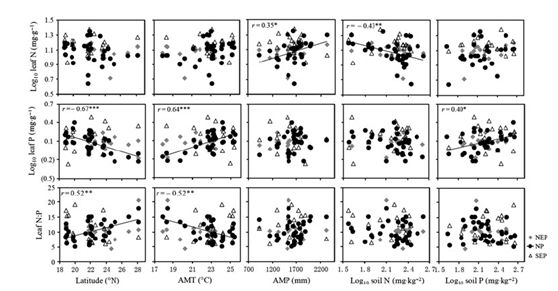Name:
Tell:
Email:
Organization:
Plasticity in Latitudinal Patterns of Leaf N and P Clarified in O. rufipogon
2014-03-21
Oryza rufipogon (O. rufipogon) is a widely distributed tropical or subtropical wetland species that exhibits a northern range limit in southern China and northern Burma that has remained stable. It is the ancestor of Asian cultivated rice (O. sativa), and also the most important germplasm for rice improvement.
It’s widely accepted that plant nutrients may depend primarily on latitude, climate and soil fertility. Ecological stoichiometry is fundamentally used to explain the pattern of an organism’s C: N: P stoichiometry across ecological gradients. Characterizing the adaptability in nature of plant stoichiometric patterns across geographic or environmental gradients is important in advancing our understanding of the organization of plant–nutrient relationships.
Under the supervision of Prof. LIU Guihua from Wuhan Botanical Garden, Ph.D. student ZHOU Wen examined correlations between plant nutrient traits, latitude, longitude, and climate and soil variables in 34 populations of O. rufipogon across its range. They further compared the responses of population transplants at two experimental gardens: one beyond its northern natural range (Huazhong Agricultural University, Wuhan; 30°29′N, 114°19′E) and another near the southern limit (Lingshui County, Hainan Province, Hainan Island; 18°34′N, 110°02′E), to assess the nature of geographic variation in plant nutrients.
Study showed that leaf P of O. rufipogon in the field was negatively correlated with latitude and largely depended on temperature and soil P availability. Leaf N was not related to latitude but was significantly correlated with precipitation and soil N concentration. Leaf N: P ratio was largely determined by absorption efficiency of P.
Transplantation revealed that there were no significant associations of leaf nutrients with geographic, climatic or soil variables of origin in either of the experimental gardens, indicating phenotypic plasticity. However, examination of relationships between response ratios of leaf nutrients and change ratio of climate and soil environments, as well as norms of reaction in the transplantation experiment, revealed more complexity, suggesting both substantial genotypic diversity and the existence of genotype × environment interactions in these populations of O. rufipogon.
These data indicate that adaptive plasticity response of plants to temperature and soil P availability significantly explain the observed shifts in leaf N, P and N: P of O. rufipogon along latitudinal gradients.
This research was supported by the CAS Strategic Priority Research Programme and the China National Science Foundation. Results were published in Plant Biology entitled “Plasticity in latitudinal patterns of leaf N and P ofOryza rufipogonin China”.

Leaf N, P and N: P ratio in relation to latitude, annual mean temperature (AMT), annual mean precipitation (AMP), soil N and P concentrations for northern transplant populations (NEP), natural populations (NP), and southern transplant populations (SEP) of O. rufipogon. (Image by WBG)